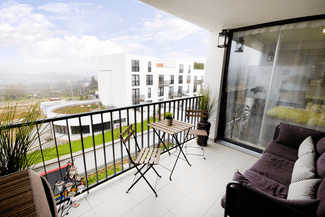California Balcony Inspection Requirements: SB721 and SB326

Often referred to as the “Deck and Balcony Inspection Bill,” California SB721 was enacted in response to the balcony collapse at Berkeley’s Liberty Gardens Apartments, which resulted in multiple deaths and serious injuries. The bill went into effect on January 1, 2019.
SB721 requires that buildings containing three or more dwelling units have their Exterior Elevated Elements inspected on a regular basis. To maintain compliance with the provisions of SB721, owners of buildings with three or more units must complete the first inspection by January 1, 2025, and re-inspect them at a minimum of every six years.
Inspection reports are required to be kept on premises by owners for a minimum of two inspection cycles. This means that at least the two most recent inspection reports (12 years) are required to be onsite to meet the standards set forth in SB721. If the owner decides to sell the building, the report should be sent to the new owner.
If you are not sure which California Balcony ordinance category your building would fall under, learn more HERE about the difference between SB326 and SB721.
Qualified Inspectors
The Inspection Report of exterior elevated elements and associated waterproofing elements must be performed and certified by a licensed architect, civil or structural engineer, or a certified building inspector. Other acceptable inspections and reports may be performed by building contractors who hold specified licenses.
However, contractors may not perform the repairs of any deficiencies or repairs found during their inspection. Repairs need to be made by licensed contractors other than the one performing the inspection.
Areas and Extent of Inspection
Inspectors must address the following areas and certify that they follow local, state and industry building codes by evaluating the condition and structural integrity of all components of the balcony or deck, including:
- Water intrusion or damage.
- Check edges, walls, and flashing for rust and corrosion and proper use and installation of waterproofing materials.
- Inspect finishings and coatings for integrity and note cracks and other indications of water intrusion that may surface prior to the next inspection.
- Railings, banisters, stairs and supports must be securely fastened and structurally sound, including any support beams and inter-dependency with building support.
- Wood framing must be inspected for existing rot and damage that affects structural integrity.
A written report with photographic evidence must be completed with any damages that constitute an immediate threat to life and safety highlighted for immediate repair.
All reports that indicate life safety issues and the need for immediate repairs must be filed with the building officials of the local municipal or county building department. Owners with reports that note needed emergency repairs must apply immediately for emergency repair permits and undertake those repairs before continued use of the EEE.
Owners whose reports call for non-emergency repairs have 120 days to obtain applicable permits and undertake repairs. Inspectors are required to notify local enforcement agencies of repairs that are not completed or acted upon within 180 days of the inspection.
Owners who do not comply with an order of repair issued by local enforcement agencies are subject to civil penalties that could result in a building safety lien against the property.
It is strongly advised that you have a professional perform the inspection. However, you can do some basic checks yourself to determine the EEE’s current structural integrity.
Here are the five warning signs of unsafe Exterior Elevated Elements:
Lost or missing connections – Your outdoor deck should be secured with nails, screws and proper connectors. Any missing pieces should be noted and photographed.
Loose connections – These are often difficult to see because the connections are still in place. Loose or wobbly planks and boards are clear indicators of a problem.
Corrosion – Rusted nails and corrosion undermine the structural integrity of the deck.
Rotting wood – Pressure-treated wood for outdoor projects is designed to last a long time but not forever. Decay and rot happen because of external exposure to the elements.
Cracked wood – Cracks are similar to rotting wood. Cracks can also weaken a deck, rendering it unsafe.
If you are not sure your building’s balcony, stairways, walkway or deck are safe for continued use, contact EEEAdvisor, an expert with more than 30 years’ experience in this industry. Their professional engineers are ready to help you.
It is strongly recommended you not attempt repairs on your own as doing so may prove dangerous to you and your family.
About the Author:
Omid Ghanadiof is co-founder of EEEAdvisor, a Southern California engineering firm that specializes in engineering structural inspection to help owners and HOAs comply with balcony inspection ordinances SB-721 and SB-326.















 Accessibility
Accessibility